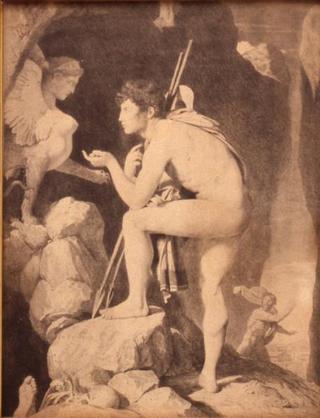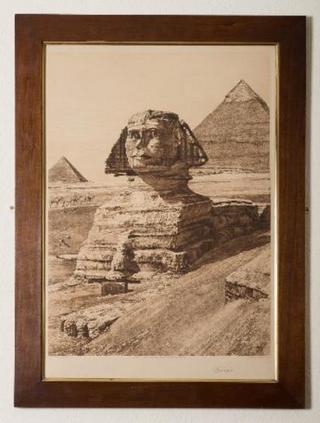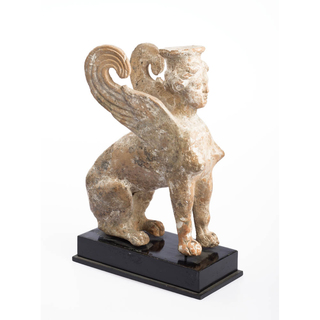JOIN THE CONVERSATION
Let’s talk!
An open dialogue between the museum, the project and its online visitors.
I'm really interested in the topics below and would love to hear your thoughts...let's see where the conversation takes us. Whether you want to tell us something about your pet cat, feline folklore or offer a reference - it's all welcome.
Join the conversation by emailing me at laura.robertson@network.rca.ac.uk.
Responses may be added to the dialogue: please include your name (to be displayed next to your response) and your relationship to either the Museum or the Royal College of Art.
eg. Sigmund, Freud Museum online visitor / Anna, RCA2020 visitor / Sphinx Cat, RCA student
The Sphinx
To begin, I’d like to put some curious cat whiskers out to investigate notable felines within the museum’s collection.
Freud’s collection of antiquities, rich in the history of archetypal syntax, and how these figures come together as an accumulative is enough food for years of art making. There is one creature, though, that is of particular interest to me. Appearing in multiple depictions around Freud’s study, the Sphinx has a marked presence. At Bergasse 19 – Freud’s home in Vienna – in what might be called pride of place above the couch in his consulting room hung a reproduction of Ingres’ painting ‘Oedipus and the Sphinx’ . Amongst other examples of the Sphinx’s recurring appearance in the collection is a large etching of ‘The Sphinx at Giza’ and a terracotta figurine. Considering the story of Oedipus, I’m not so interested in Oedipus, but rather the Sphinx.
Let's talk about the Sphinx’s presence in Freud’s study as well as Freud’s relationship to it?...
Whilst Freud’s relationship to the Sphinx seems not to be extensively explored, his interest in the creature is tangible in his collection, and I wonder what might have happened had Freud been guided by the Sphinx rather than Oedipus as a starting point?...
And any Sphinx related chat...
I see the Sphinx as a typical example for the conditio humana, a liminal creature split between the condition of being human and the state of human nature, perpetually stretched between the constant desire to strive, to become, squashed between past and present, life and death… As you rightly pointed out, the figure represents both guardian, through its superior intuition and ability to understand, and monster, since the condition of human nature, when pushed to the edge, threatens to revert to monstrosity.
Alex, UCL
Add your thoughts here by emailing me
at laura.robertson@network.rca.ac.uk



Symbolic Order and Gender
Perceiving the Oedipal stage as the moment of acquisition of language – the symbolic order. It is a moment that creates in us the need to find our places as men and women within the symbolic order. Contemporary artists are often breaking up that language and symbolic order – exploring a complexity and confusion of the symbolic, discovering unstable alternatives. It seems natural, then, that my work has situated itself within the Sphinx figure who resides in the liminality of this complexity. I have been reading that Freud related the Sphinx not to the mother but to the father and that he took an interest in Egyptian mythology as ‘an archive of ambiguously gendered divinities’ suggesting ‘new psychoanalytic ideas that could break through the essentially male confines of most of his cultural theory . ’
I wonder if anyone has anything to say on ways in which the Sphinx and Egypt could have figured as an unstable gender alternative for Freud, at least in the pre-war years, before his interest in Egypt took a different set of associations in Moses and Monotheism – as well as a gateway into an alternate world view, or an alternate language to the Hellenic language familiar to classically trained medical professionals?...
Concerning gender ambiguity, I personally find it difficult to tell if a cat is a male or female at first glance. The elegant way they move in contrast with the aggressive manner they attack, the way they can be cute and socialise for convenience but when they stop needing others will prefer to 'stroll' alone, is almost impossible to explain through a human social gender construction perspective.
Tere, RCA student
I understand that Freud associated the sphinx with the father …which seems odd when I think of the sphinx picture in his study that focuses in on the sphinx’s prominent human breasts as though they define an important feature of its identity.
Josh, Freud Museum online visitor
Add your thoughts here by emailing me
at laura.robertson@network.rca.ac.uk
Transitional Objects, Complexity and Rationality
A sphinx, by its heritage, is a transitional figure – and as such proposes a space of transition. The other feline figure in the collection, less notable than the Sphinx but making multiple appearances and sitting on Freud’s desk, is Bastet, originally a lion goddess, a role shared by other Egyptian deities such as Sekhmet. Over time Bastet and Sekhmet became characterised as two aspects of the same goddess: a paradoxical unifying and splitting. Bastet took on the form of a domestic cat that protected the home. However, she is still a fierce predator and blood-thirsty Sekhmet reminds us of the cat’s capacity for malevolence. Bastet, like the Sphinx seems to represent both guardian and monster, a straddling of dualities. She occupies the liminal space of both paradox and transition in her domesticated form combined with her ability to turn and wreak havoc if she so chooses.
If we were to consider Freud’s artefacts as transitional objects, I wonder if they could have offered up different states or narratives for Freud and those who came to see him; perhaps a complexity or liminality that language and rationality didn’t offer?...
Or do you have anything to say about Bastet or Sekhmet?
..that is indeed a very interesting point.
Ailouros ( the feline) was the Greek version of Bastet and and for some Artemis too, the godess of hunting.
Marina, RCA2020 visitor
Add your thoughts here by emailing me
at laura.robertson@network.rca.ac.uk
Cat Deities
Cat deities
Are there other felines in the collection that we have not spoken about?...
Do you have anything to say about cat deities in general?...
Is there anything else that you would like to input into the dialogue?...
I think that the idea of using a feline as deity, might be explained by the fact that cats, in difference from dogs or other animals that can be domesticated, always keep their independent life. While dogs remain faithful to their owners, cats always have their independence. They would pretend to be something but then change.
Tere, RCA student
In multiple cultures the felines have been animals associated with divinity. Both the mayas and the Aztecs had 'jaguar deities'. Maybe there is something about how they walk and carry themselves with such elegance.
Tere, RCA student
Popularly, cats tend to be associated with old souls and wisdom. Urban legends around cats still remain in our contemporary society. For example, I once heard a story where a cat had sacrificed himself and absorbed the bad energy of a space to protect his own.
Tere, RCA student
Add your thoughts here by emailing me
at laura.robertson@network.rca.ac.uk
JavaScript is turned off.
Please enable JavaScript to view this site properly.